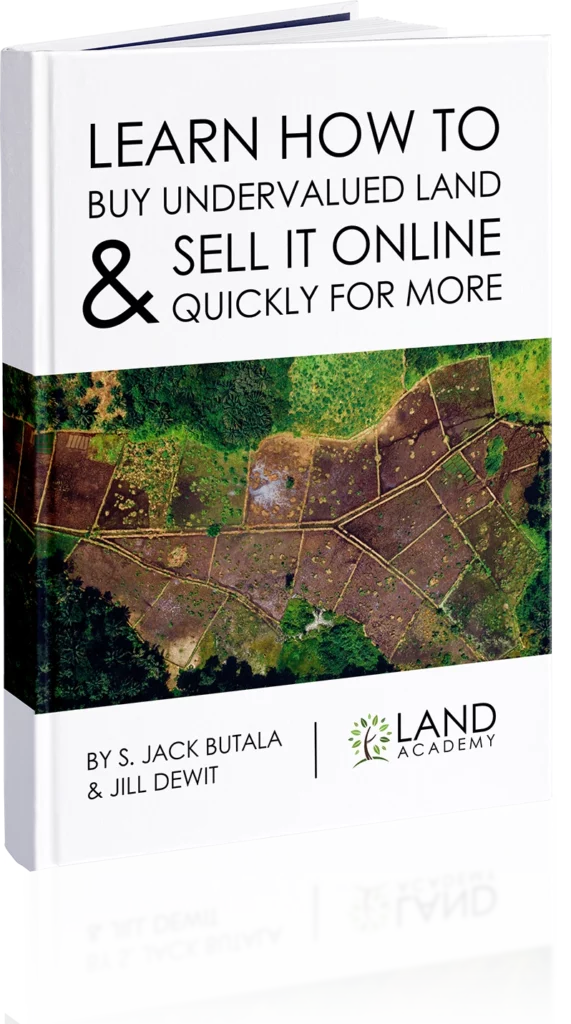Introduction To The Five Phases Of Building A Real Estate Empire
This week, all week, we are talking about the five phases to your real estate empire, and each day we’ll take up each step. Now, we are talking about the first step. Nailing down the basics in your land business. I’m going to talk about the technical stuff. As always, Jill is going to talk about the more interesting, fun, and the all-important points to creating a real estate deal.
I’m going to talk about your logo, your colors, your office space, and decorations. All of that.
I can’t wait to hear it. How do you come up with the logo? Let’s start off with some fun stuff because this is an intense week.
I’m not even sure you need one. For our land business, we have never had a logo. We never even thought about it. We had a name. The only thing that we went with the name of our land business was something that was easy to look up and spell. That’s it and says what it is. That’s it and make sure it’s a dot-com. I never cared about the colors and all of that. It’s funny. I like how you did this, too. I was thinking, I learned this from you, first gear, second gear, and third gear. All that. Now is the first. That’s first gear.
Overview Of The Five Phases
Here are the topics. On Monday, we are going to talk about nailing down the basics of your land business. On Tuesday, which is phase two, putting your land business on autopilot. As we go through these, I will talk about my personal experience and maybe shifting from first gear to second gear to third gear and my personal land business wasn’t as efficient as it could be as yours could be, let’s put it that way.
On a Wednesday, phase three, expanding your land business into other real estate types, super important. Thursday, phase four, institutionalizing the operations portion of your real estate business. You’ve heard this probably by now. If you are an entrepreneur, you probably shouldn’t be working in your own business, which is true. What that means is you shouldn’t be running the operations portion of your business.
You are the startup people. We are all startup entrepreneurs here. If we were masters at operations, we would have other jobs with private equity companies or things like that. We are startup people. On Friday, my personal favorite, phase five is staying out in front of all of the changes that go on and the environment so that you can survive.
The title of Friday’s show is capitalizing on the ever-present industry and cultural changes in real estate. A great example is, and then we’ll get to the topic here. There’s more competition and traffic out there than there ever has been from a mailing standpoint. There’s more people involved in the business because it’s so cheap and easy to get in as you’ve probably decided for yourself already. We’ll talk about how we deal with that, and it’s pretty much my full-time job other than doing Jill’s mail.
I was going to say, “Where is he going with that one?” Other than making sure everything on the outside of the rig runs smoothly. Is that your other job? I’m inside. He’s outside.
Let’s very briefly talk about where we are and what we are doing this summer. It’s not summer anymore. It’s not even fall anymore.
It’s fall. We are in the not quite Pacific Northwest, but we are in the Northwest, let’s say that. It’s still lovely out. As we’re doing this, it’s in the 60s like high 60s, but it’s all going to change. We were still in our sweet RV. We left in May. I have seen pictures of the house. It’s still there. That’s about it.
We are out in the west part of the Western part of the country doing real estate deals. It’s first for Jill and I to ever in person do real estate deals, and it’s been a blast. We were having fun meeting a ton of people, which usually is not my first most favorite thing, but a lot of fun people, a lot of interesting real estate and time is changing.
Learning the culture. Everywhere is different, too.
Each day on the show, we answer a question from our Land Academy member Discord forum and we take a deep dive into land related topics by popular request. Go ahead, Jill.
Handling Limited Comp Data And Testing Mailer Pricing
Cooper wrote, “I’m struggling with an area that I mailed and I received a bunch of responses accepting my offers. It repeatedly seems to have very few up to twelve months back of sold comps of similar sized properties.” He’s got the offers coming back but he doesn’t have a lot of comps now to go back and compare them to.
“If it does have a recent comp, they can be 25% of the for sale of the properties, which makes me think it’s another land investor or perhaps a one-off property issue. I reached out to a local experienced realtor for their opinion on several and should hear back soon. In these situations, how much weight or trust you put into the limited comp information, versus realtor opinion versus sale prices? If there are not many recent sold, would this be a signal or a red flag? Thank you for your time and assistance.”
Cooper, you are doing everything right. You sent a bunch of mail out and you priced it, hopefully, within reason accordingly. You are receiving positive responses. People are signing your offers and sending them back. I do not place specific emphasis on sole comparison values. There are 3 or 4 things that you need to look at when a property comes back. This is what Jill and I do on the Thursday call for our members. We review their deals, and we have been doing this every Thursday for years.
You need to look at how the internet or how the internet values like kind real estate in the area that you believe are comparison values. Zillow calls it as estimates. Realtor.com has all kinds of comps, and then you should look at what, like you are, a comparison value, and for sale property. It’s important to remember where comparison values come from. Sold comparison values have to be manually listed on Zillow by the seller or by the real estate agent, or the person who’s selling it.
That leaves a lot of unaddressed sold comparison values because it’s not directly on MLS, and then let’s not forget about property that’s been sold directly like buy a piece of property and I sell it to Jill or deed it to Jill, or vice versa. It never hits the MLS. It does not become a comparison value unless you are pulling comps from the actual recorder from the county. I don’t want to make this sound complicated.
However, you should be able to look at a piece of property that you are thinking about buying and look at the properties around it and look at it for a reason. Does it make sense that I sent a $30,000 offer out of all the other houses, structures, or land values that are 2 and 3 times that? In the case of a house, it should be 4 to 5 times.
The way that you are going to get confidence doing this is by doing it often and getting some reinforcement from whomever you choose. This is a very popular topic in Discord. A lot of people had a lot of things to say, and one of the real things that people said was, “This should be part of the process when you are pricing your mailer.” This is what we call testing for a reason.
At the very end of the mailer that you put together and you are done pricing it, you go down. The list of the mailer, in the Excel file or the relational database and test properties. Test them and assume that they came back. if you have a signed executed offer and it came back, test it. You haven’t spent any money on mail yet and you might find you can’t value these properties. This has happened to me. Over the years, it’s happened a lot. There’s no value in anything. I would ditch the mailer and then move on to a place where you have huge confidence in the fact that you are buying property at 20% of retail.
I don’t know if we are differing in opinion or if it was a little goof, but the land you are buying should be worth 10% of the houses, at least. If you are paying $100,000 for a piece of dirt, you better be ending up with a $1 million house. You had said 2, 3, or 4 times.
Only other land values.
You had said houses. I want to clarify that. If there’s a $1 million house, you could spend $100,000 on the dirt. We are good with that. If it’s a $300,000 or $400,000 house, you cannot spend $100,000 on the dirt. As far as the question, you’re like, “I have got that realtor. I’m working in a realtor opinion. I’m having trouble with these sold comps and I’m looking up for sale.” I start out weighing them equally. I do. When I look at these things and they come back, I want the local opinion because I want to know what he’s got lined up like how many calls. The local opinion is going to tell me a lot as far as what people want.
If he’s like, “It’s been slow,” or “People are blowing up my whatever. I sold one last week. I wish I had ten of those.” That tells me something. The second one is the sold comps. I love looking at that 3 or 6 months back, or a year back. Has it been getting better? Maybe even go back once in a while further. If you see like, “Two sold and then 10 sold and now 50 sold? There’s a trend here. Things are happening.” That’s good. Not just for volume, and then you can see the prices, “They keep going up. Look at this. It’s getting a little more competitive. Moving up in price because people want to move here. More demand.”
The last thing is for sale. I do value that, too. Not that it’s real, because some people do have their own, “We are going to list it for this price and I’m going to hang out.” With weird numbers. You can throw out the outliers high or low on the active and go, “This is a general opinion. I can see what people think things are worth in this area again. I weighed them pretty much equally.
This portion of the business, this valuation portion, I obsess on to an unhealthy level. I go into a market long before we send out mail to see if it’s viable to send out mail or even buy property there. I’m not bragging, I’m saying if not anything else, it’s not an emotionally healthy part of my personality. I want to know what parts of the market, let’s say it’s a county that is expensive, what parts are not, which parts are untouched maybe because they are too far out, and I want to know why.
I love this question. I don’t remember getting a question like this. Maybe I’m reading a lot into it, but I don’t remember getting a question like this because it’s very in-depth and it’s good. You want to get to the bottom of why. If a deal comes back like this and Jill and I are looking at each other and we are saying, “I don’t know if this is a good deal. Price-wise I love the dirt. The markets look fantastic, but I can’t see if we won’t do the deal.”
She’ll go back or knock so much money off of it that we have to do it. There are other bigger factors in this. This could be a whole week, by the way. If the county or the surrounding counties are doing well and you are looking at 40 acres for $18,000 and every other 40-acre property in the area of the state is $180,000 plus or $800,000 plus in some markets. You have to start to say, “I might take a risk on this because it passes all the As. I can’t get any sole comps.”
I looked at a deal in the very far Northeast part of the country in a state that I have not done many deals in. I’m looking at and scratching my head going, “There’s not a lot to go on. There wasn’t.” It was like a buy for $30,000 and sell for $70,000 they thought. I’m looking around going, “I can’t.” There are so few comps that I had to fall back on. Here’s a good fallback for you, Cooper.
I had to fall back on what I think is the closest property, which sold for like $40,000, and this is a buy for $30,000 something. It was a deal funding issue. I had to go back and say, “I’m sorry, but you got to look at this comp and you got to look at this stuff here.” I had a couple different ones. I said, “I would even call this agent and talk to him about it, but based on this best one I can do, I can’t see any way out of it other than not paying $30,000 paying $10,000.” It might work. In that case, I’m like, “For $10,000, I will roll the dice, but for $30,000 I won’t.” I’m not going to buy for $30,000 to sell for $40,000. With an agent and commissions, now we are both splitting $5,000 barely, so that won’t work.
Jill and I are in a process of completing a deal and neither one of us liked that at all when it first came across our desk. We realized later that we loved the deal but we hated the price. We couldn’t make the price work, and so Jil went back in and got it for $125,000 cheaper.
They had to catch up with us.
I’m learning a lot during these deals in person because I’m not used to this. This has been decades of me doing this stuff on the phone and on the internet. When Jill gets in front of people and she talks with them, they are very much more likely to reduce the price. Please test all this stuff for a reason before you send the mailer out. Cooper, this is a great question. Our topic is nailing down the basics in your land business. This is phase one of the five phases.
Let’s call it first gear. I like first gear. You taught me that. It makes sense to me. You’re getting started. You are rolling.
The way attrition works, it’s a funnel you and you want to make it to the end of the bottom. You want to make it across the finish line here, and all five of these phases. There can be issues with every single phase of this, but nailing down the basics in your land business is as follows, and they are the modules in Land Academy 3.0. They are the basic modules that we talk about in Career Path.
Mastering The Fundamentals
You need to get educated. That’s the first part of nailing down the basics in your land businesses. You are reading because, hopefully, you are utilizing all the free resources around the internet, this included to learn. At some point, you’ll decide whether or not you want to belong to a group like Land Academy. Hopefully, it is Land Academy, and learn from other people that have been where you are at one point like Jill and I and have made it down through that funnel.
The first part is education. There are phases to that, then you get serious. Eventually, you are going to send a review where you want to send mail. Get real comfortable and confident. You are building confidence in this stage with sending mail to an area backed by data. Every decision we make in this is data driven. As evidenced by the question, he’s looking for data or looking for data to confirm and validate his purchase price.
When you are done, I will go because I have five different things, too.
You get the mail out, and then manage the inbound flow. What Jill brings to the table is managing and converting those inbound responses from the mail into real estate deals, buying it and selling it. Those are the basics of the land business. If at any point that doesn’t make sense to you or you can’t stand it, or you are not willing to get a business partner or hire somebody to do the stuff you don’t want to do, this can be a problem. A lot of people find out that it’s not all peaches and cream. There’s a lot involved unless you have a certain personality type. For Jill and I, we are very fortunate because she does the stuff I don’t want to do and vice versa.
Here’s what I think. This is the very beginning stages here, and there are five things you’ve got to have locked in if you are going to be successful here in your land business, and as a new person. Number one, money. You’ve got to have money to get going, send out mail, and do data. Not necessarily buy the deals, but you’ve got to have money saved up or it’s not going to work. You can’t come at this with $1,000. You need to have at least like $10,000, I’m going to be honest, to get rolling. The good news is, as we have talked about many other shows, starting a business with $10,000 is like, “What are you talking about? That’s amazing.”
If I wanted to buy a Circle K, it would cost whatever, or any restaurant or pizza joint. We have been there. Every other business, it’s astronomical. This is nice. Number two, you need to be in the right frame of mind. You got to be ready. You have to have your family and head ready, and your calendar clear, however, it’s going to work out with your regular job and how you are going to fit this in. You’ve got to have that ready to go.
Number three, you’ve got to have tools. You can’t do this. You can’t sit down and Google your way through this. No. That’s part of where the money comes from, and you are going to need to have access to the data and phone system. You got to have a good computer, good software and a male company thing. You’ve got to have all this stuff lined up.
The fourth thing is education. We always agree there. Do you want to spend ten months learning to do this or ten years? Think about it. You can catch up and get a lot done in Land Academy in ten months versus, or you can wing it and google your way through this and get ten years then maybe catch up to us. We’ll see. I wish I had us. When we started, that was the thing. At least, I had Jack. Jack had nobody. That was good.
The fifth thing is the basics in your land business and nailing your land business. I started with money. Your frame of mind. I’m not using the word mindset because it’s overused, tools, education, and the last thing is practice and experience. Nailing down the basics. You’ve got to do some deals. Until you have at least ten deals, I would say maybe 20 or 30, you are new. You need to get more experience, then we can move into second gear.
It’s building confidence. You might have come from another professional environment, engineering or something like that, or maybe you are a real estate professional or former business owner, the number is going to be less. You are going to know when you are confident. You have to be very confident as a business owner, whether it’s a restaurant owner or manufacturing. You cross over that point where, “I pretty much know what’s going to happen next.” Ten to fifteen deals is good, or twenty whatever you said. Join us in the next episode where we discuss putting your land business on autopilot. This is phase two or Jill is calling it second gear. You are not alone in your real estate ambition. We are Jack and Jill. Information and inspiration to buy undervalued property.















